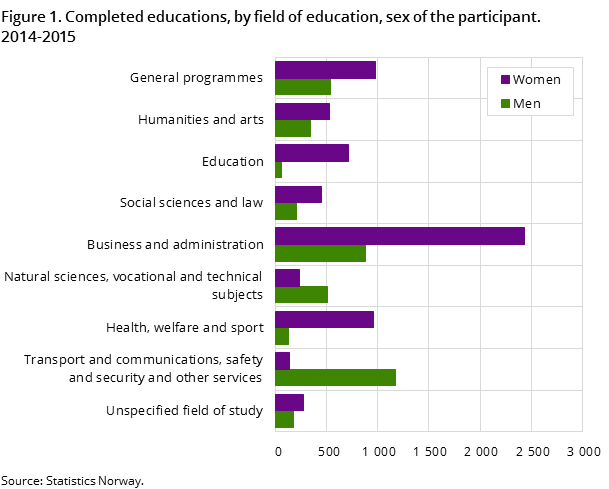Content
Published:
This is an archived release.
Fewer pupils in web-based courses
In total, there were 14 200 participants in web-based schools in the autumn of 2015, a decrease of 13 per cent from 2014. Almost two thirds of the participants were women, and only a small number of participants were over the age of 50.
| 2014-2015 | |||
|---|---|---|---|
| Completed educations | |||
| Total | Males | Females | |
| Special field, total | 10 753 | 37 | 63 |
| General programmes | 1 525 | 36 | 64 |
| Humanities and arts | 870 | 39 | 61 |
| Education | 773 | 8 | 92 |
| Social sciences and law | 661 | 31 | 69 |
| Business and administration | 3 308 | 27 | 73 |
| Natural sciences, vocational and technical subjects | 751 | 68 | 32 |
| Health, welfare and sport | 1 092 | 12 | 88 |
| Primary industries | - | . | . |
| Transport and communications, safety and security and other services | 1 317 | 89 | 11 |
| Unspecified field of study | 456 | 40 | 60 |

Almost 63 per cent of the participants were women, a share that has remained constant over the years. A majority of the participants were in the age group 20-39 years, while only 7 per cent were aged 50 or over.
The various web-based schools offer courses at different educational levels; upper secondary, tertiary vocational and university level. Two out of three participants were enrolled in courses at upper secondary school level, 13 per cent at tertiary vocational level, and 19 per cent at university level.
Most course completions were in business and administration subjects
During the academic year 2014/15, there were 11 000 course completions. As in previous years, the number of course completions was highest in 'business and administration subjects'; 31 per cent of the total number of completions.
Gender disparities
There are marked gender disparities between the subjects. Education is a subject with a high share of women, making up 93 per cent of all course completions in the subject. Health, welfare and sport is another example. Transport and communications, safety and security and other services and Natural sciences, vocational and technical subjects are subjects more often chosen by men.
This page has been discontinued, see .
Contact
-
Statistics Norway's Information Centre
E-mail: informasjon@ssb.no
tel.: (+47) 21 09 46 42
